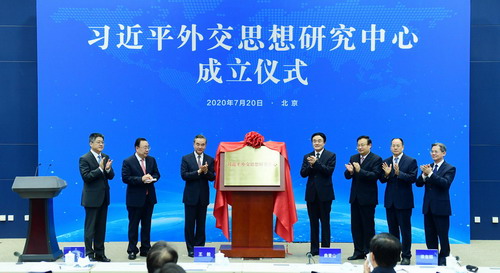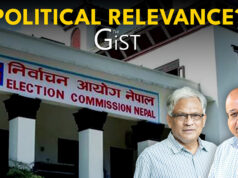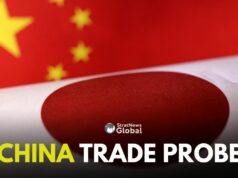NEW DELHI: After the Covid-19 outcry against China, which has been accused, across continents of deliberately or inadvertently spreading the virus, Beijing is sending out a stern message—it is ready for a confrontation, united under the leadership of Xi Jinping.
Xi Jinping’s status on par with Mao Zedong, the founding patriarch of the People’s Republic of China (PRC), was rebooted earlier this week. On Monday, a book on Xi Jinping Thought on Diplomacy was released in Beijing. The publication focused and expanded on the external dimension of Xi Jinping Thought for a “new era” that was unveiled in October 2017 during the 19th party congress of the ruling Communist Party of China (CPC).
Xi’s stature comparable with Mao had been already cast in stone during that twice-a-decade conference, when the CPC decided that Xi’s Thought would be inscribed in the Party constitution—an honour that had been bestowed only on Mao. Even the stature of Deng Xiaoping, the architect of China’s reforms following Mao’s death, which unleashed a juggernaut of prosperity, was seconded to Mao and Xi. But unlike these two leaders whose ‘thought’ had been recognised in the Party-state’s basic law, the Party decided that only Deng’s Theory—a rung lower than Thought—would be included in the CPC’s constitution.
Besides, by 2016, the CPC had already anointed Xi as the country’s “core leader”—an honour that crowned only select leaders of the PRC, including Mao and Deng. The title of “core leader” meant that the Party trusted Xi to exercise near absolute power. But what was then the need, on Monday, to reaffirm Xi’s elevated Mao-equivalent status, which he has already exercised since the autumn of 2017?
The answer lies in the context. Ever since the spread of Covid-19 pandemic that originated in the central Chinese city of Wuhan under a cloud of suspicion that the leakage of the virus, which could be a biological weapon, may have been deliberate, a global outcry targeting China was triggered.
In response, the CPC decided that instead of hunkering down in defence, it would be best to go on the offensive, by flexing the military muscle of the People’s Liberation Army (PLA). Alongside, it was also equally necessary to convey the message that in no way had Covid-19 dented Xi’s paramount leadership and authority in the PRC.
The release of the book, spotlighting Xi’s Thought on Diplomacy with a subtext of Mao, was meant to convey the message that the Chinese President’s supreme leadership and peerless power remained undiminished. The belligerent messaging from China was also meant to counter India, the United States and its allies on a psychological plain.
China had been pushed on the defensive after a resurgent India stood up to the intrusion of the PLA across the Line of Actual Control (LAC) in the lofty highlands of Ladakh. In the Indo-Pacific theatre, the Americans sent in two aircraft carrier task forces in the South China Sea after unambiguously rejecting all Chinese claims in these waters, which are contested by key ASEAN countries including Vietnam, Philippines, Malaysia, Thailand and Brunei. From Ladakh in the West to the West Pacific in the East, a nervous China watched the possibility of a new coalition targeting Beijing taking shape.
In its counteroffensive on Monday, Beijing has resurrected the imagination of the Middle Kingdom 2.0 under Xi’s stewardship. Under the tradition “Zhongguo” or Middle Kingdom concept, which can be traced to the Zhou dynasty, Chinese imperial dynasties, positioning China at the centre of the universe, had combined trade and commerce with ruthless military force. This was to enable them to forge a tributary system, with China as the core, which intruded into parts of Central Asia, the Korean Peninsula and throughout south-east Asia with the intent of consolidating the central heartland.
Even in the pre-Covid 19 era, many analysts had been accusing Xi of harbouring Middle Kingdom dreams, in his imagination of the great rejuvenation of the Chinese nation. “It now seems evident that the Chinese president is essentially seeking to return China to the traditional position it has exercised in Asia through much of its long history as the dominant regional power, to which other countries must defer or pay tribute,” observed Gideon Rachman of the Financial Times in an article in the LSE IDEAS special report. He added: “When the process of reform and opening began in China in 1979, the country found itself in a historically unfamiliar and deeply humiliating situation… Under these circumstances, China was forced to adopt a historically unfamiliar posture of humility. Throughout the first years of the policy of reform and opening, which began in the late 1970s under Deng Xiaoping, China made every effort to be friendly and cooperative with its booming capitalist neighbours.”
During the inaugural of the Xi Jinping Research Center for Diplomatic Thought, also on July 20, Chinese foreign minister and state councillor Wang Yi was astonishingly transparent in declaring that Xi’s China continued to entertain ambitions of a Middle Kingdom 2.0.
“China today is approaching the realisation of the dream of the great rejuvenation of the Chinese nation as never before, and approaching the center of the world stage as never before,” Wang said, according to the machine translation of his speech, posted on the Chinese foreign ministry website, from Chinese to English.
He also made it plain that in the era of Xi Jinping’s Diplomatic Thought on Socialism with Chinese Characteristics in the New Era, China had arrived at a stage where it would exercise leadership in shaping the global agenda. “We take the initiative to lead the reform of the global governance system, promote the development of globalization in a more inclusive… direction, and promote the evolution of the international order in a more just and reasonable direction,” Wang observed.
Wang also said that the Chinese nation “has stood up, grown prosperous and is now becoming strong,” referring to three stages in the evolution of the PRC. In CPC’s thought, China “stood up” under Mao when China became a unified nation and it had “grown prosperous” under Deng’s stewardship. But China is meant to grow “strong” on Xi’s watch, implying that prosperity would be matched by military prowess, as well as an extrovert, outward looking, and agenda-setting foreign policy.
In the “two centenary goals” encapsulating China’s Middle Kingdom fantasy, Xi had declared during the 19th Party Congress that China would become a “moderately prosperous society” in 2020 and an unrivaled fully developed country by 2050, marking the centenary of PRC’s formation.
With Xi, after the Covid-19 pandemic, emerging as a combative figure, fixated on achieving his country’s Middle Kingdom aspirations, India has to dig deep into its civilisational reserves, on the military, ideological and geo-cultural plain to counter the sustained hostility radiating from Beijing. “By the second half of the 21st century, our biggest opponent will definitely be India,” acknowledges Xilu.com, a Chinese website, which is part of the media universe of the People’s Liberation Army (PLA).
As expected, the Indian armed forces are already demonstrating their professional acumen along the LAC. On the ideological platform, it is essential to have an unwavering, clear-eyed perception of China’s DNA, as demonstrated in a 1950 letter, written by India’s first deputy prime minister Vallabhbhai Patel to Jawaharlal Nehru soon after Mao’s military attack on Tibet.
“Recent and bitter history also tells us that communism is no shield against imperialism and that the Communists are as good or as bad imperialists as any other. Chinese ambitions in this respect not only cover the Himalayan slopes on our side but also include important parts of Assam,” Patel wrote in the context of the Tibet issue. He prophetically added: “While our western and north-western threat to … security is still as prominent as before, a new threat has developed from the north and north-east. Thus, for the first time after centuries, India’s defence has to concentrate itself on two fronts simultaneously.”
Patel clarified further: “Our defence measures have so far been based on the calculations of a superiority over Pakistan. In our calculations we shall now have to reckon with Communist China in the north and in the north-east, a Communist China which has definite ambitions and aims and which does not, in any way, seem friendly disposed towards us.”
As there are no soft options, Patel’s well grounded advice is gold dust to prepare for a long contest with a belligerent, who is there to stay, challenging not only the frontiers but India’s inland reserves as well.
(The author is former Strategic Affairs Editor of ‘The Hindu’ and has reported from China for many years. Views expressed in this article are personal.)





